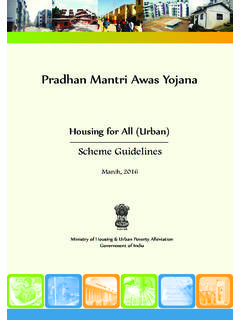Transcription of SLUMS AS EXPRESSIONS OF SOCIAL EXCLUSION: …
1 SLUMS AS EXPRESSIONS OF SOCIAL exclusion : explaining THE prevalence OF SLUMS IN AFRICAN COUNTRIES Ben C. Arimah Chief, State of Cities Section City Monitoring Branch United Nations Human Settlements Programme (UN-HABITAT) Nairobi, Kenya Email: The views expressed in this paper are those of the author and do not reflect those of the United Nations Human Settlements Programme. SLUMS as EXPRESSIONS of SOCIAL exclusion : explaining the prevalence of SLUMS in African Countries Abstract One of the most enduring physical manifestations of SOCIAL exclusion in African cities is the proliferation of SLUMS and informal settlements. People living in these settlements experience the most deplorable living and environmental conditions.
2 They are also excluded from participating in the economic SOCIAL , political and cultural spheres of the city. This paper accounts for differences in the prevalence of SLUMS among African countries. The empirical analysis identifies substantial inter-country variations in the incidence of SLUMS ; and indicates that higher levels of income, greater financial stability and investment in infrastructure will reduce the incidence of SLUMS and by extension reduce SOCIAL exclusion . Conversely, the external debt burden, high levels of inequality, unplanned and unmanaged urban growth, and the exclusionary nature of the regulatory framework governing the provision of planned residential land contribute to the prevalence of SLUMS and squatter settlements thus increasing levels of SOCIAL exclusion .
3 1 Introduction One of the most enduring physical manifestations of SOCIAL exclusion in African cities is the proliferation of SLUMS and informal settlements. People living in these settlements experience the most deplorable living and environmental conditions, which are characterized by inadequate water supply, squalid conditions of environmental sanitation, breakdown or non-existence of waste disposal arrangements, overcrowded and dilapidated habitation, hazardous location, insecurity of tenure, and vulnerability to serious health risks. Slum residents are also excluded from participating in the economic SOCIAL , political and cultural spheres of the city all of which create and nurture capabilities. Consequently, slum dwellers many who are poor in the first place are made poorer by the various forms of exclusion that they face.
4 The global assessment of SLUMS undertaken by the UN-HABITAT (2010) shows that 828 million or 33% of the urban population of developing countries resides in SLUMS . In sub-Saharan Africa, 62% of the urban population resides in such settlements. Such large concentrations of SLUMS in which inhabitants live in inequitable and life-threatening conditions impose enormous burden on city authorities that are often cash-strapped and lack the institutional and technical capacity to provide even the most basic of urban services. These settlements are also known for their atmosphere of fear and violence (Bloom et. al, 2008). It is in recognition of the challenges posed by the proliferation of SLUMS , that Target of the Millennium Development Goals (MDGs) seeks to significantly improve the lives of at least 100 million slum dwellers by the year 2020 (UN-HABITAT, 2003a)1.
5 Given that this target is very modest and hardly makes a dent on the magnitude of SLUMS in that it addresses only 12% of current slum dwellers in developing countries, a revision of the slum target has been proposed, whereby in addition to substantially improving the lives of slum dwellers, concerted efforts should be made to provide adequate alternatives to new slum formation by prioritizing slum prevention programmes and proactive planning (UN Millennium Project 2005)2. This paper contends that any attempt at improving the lives of slum dwellers and providing alternatives to new slum formation in African countries, must be preceded by a proper appreciation of the factors that underlie the formation and proliferation of SLUMS . Currently, there is an apparent lack of understanding of the forces driving the proliferation of SLUMS in developing countries.
6 In this respect, UN-HABITAT (2003b, p. 195) notes that: .. the phenomenon of SLUMS and related problems are generally little understood, and that public interventions more often than not address the symptoms rather than the underlying causes . This state of affairs can partly be attributed to the absence of studies that empirically link the prevalence of SLUMS with the possible driving forces at either the city or national level; which in turn can be explained by the fact that until recently, data on the incidence of SLUMS at various levels of spatial resolution were either non-existent or at best fragmentary. 1 Target of the MDGs stems from the Cities without SLUMS initiative launched in 1999 as a joint plan of action aimed at improving the living conditions of the world s most vulnerable and marginalized urban residents (Cities Alliance, 2001).
7 2 The revised version of Target of the MDGs reads: by 2020, improving substantially the lives of at least 100 million slum dwellers, while providing adequate alternatives to new slum formation (UN Millennium Project, 2005, p. 21). 2 The implication of the foregoing is that attention has focused disproportionately on the rapid urban growth or rural-urban migration as the sole or major factor determining the proliferation of SLUMS and squatter settlements in developing countries (Costello, 1987; Muwonge, 1980; Salih, 1980; Srivastava and Singh, 1996; Tindigarukayo, 2004). Indeed, Srivastava and Singh (1996, p. 58) emphatically state that: Migration from rural areas is the root cause of increasing SLUMS . The prominence given to urbanization as a major factor driving the proliferation of SLUMS in Africa could indeed be attributed to the continent s phenomenal urban transition.
8 In 1950, of the population of African countries resided in urban areas; by 2007, the level of urbanization increased to (United Nations, 2008). Equally remarkable is the growth in urban population, which averaged between 1950 and 1975. A major consequence of this demographic shift is the urbanization of poverty whereby the locus or concentration of poverty is moving from the rural areas to urban centres (UN-HABITAT, 2003a). In particular, Chen and Ravallion (2007) show that the while the level of urbanization in Africa increased from in 1993 to in 2002, urban share of poverty increased from to within the same period. A notable feature of urban poverty in Africa is that it is increasing faster that national poverty. While the rapid pace of urbanization experienced by African countries over the last three decades certainly plays an important role in the prevalence of SLUMS , there are other economic, SOCIAL , political, institutional and historical factors whose impacts are not known with much degree of certainty, as they have rarely been the focus of rigorous empirical investigation.
9 Although the UN-HABITAT report on SLUMS does an excellent job of identifying other factors apart from urbanization that drive the formation and expansion of SLUMS , the magnitude or precise manner in which these factors affect SLUMS remains to be investigated using quantitative data. The purpose of this paper is to account for variations in the prevalence of SLUMS among African countries using data drawn from the global assessment of SLUMS by UN-HABITAT. The availability of such data provides a unique opportunity to empirically relate SLUMS which are physical EXPRESSIONS of SOCIAL exclusion to various aspects of national development. In this respect, the paper addresses the following questions. What factors apart from the rapid pace of urbanization explain inter-country differences in the prevalence of SLUMS ?
10 What is the link between urban development policy and proliferation of SLUMS ? What role does the regulatory framework governing the allocation of residential land play in the formation and proliferation of SLUMS ? What is the nature of the linkages between the incidence of SLUMS and the macroeconomic environment? Do countries with lower levels of inequality and good governance have a lower incidence of SLUMS ? Apart from improving our understanding of the factors that drive the proliferation of SLUMS , the answers to these questions are central to identifying the challenges that African countries face in stemming the development of new SLUMS and providing adequate alternatives to slum formation. The answers to these questions should also provide useful insights onhow to reduce the levels of SOCIAL exclusion in African cities.

















